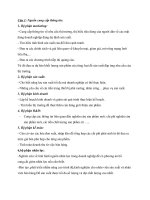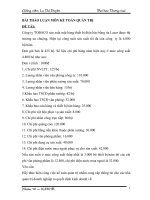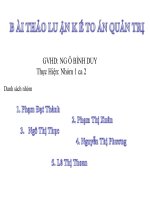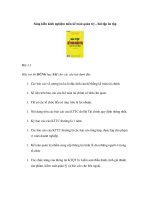tiểu luận kế toán quản trị bài tập nhóm report management accounting
Bạn đang xem bản rút gọn của tài liệu. Xem và tải ngay bản đầy đủ của tài liệu tại đây (2.59 MB, 16 trang )
<span class="text_page_counter">Trang 1</span><div class="page_container" data-page="1">
THE UNIVERSITY OF DANANG UNIVERSITY OF ECONOMICS
------
REPORT
MANAGEMENT ACCOUNTING
Instructor : Ha Phuoc Vu Class : 47K06.1 Group : 6
Member's name : Nguyen Thi Hoang Ngoc Tong Thi Kim Ngan Ho Thi Yen Nhi Hoang Thi Phuong Nhi
Da Nang, 2023
</div><span class="text_page_counter">Trang 2</span><div class="page_container" data-page="2">Management Accounting
47K06.1 Group 6 <i>–</i> 2
TABLE OF CONTENTS
I. CASH BUDGET ... 3
1. Schedule of expected cash collections ... 3
2. Merchandise purchases budget ... 4
3. Schedule of expected cash disbursements for merchandise purchases ... 6
4. Schedule of expected cash disbursements for selling and administrative expenses ... 6
5. Cash budget ... 7
II. SCENERIOS & ANALYSE ... 10
1. Discounting prices by 20 per cent, which in turn increases sales volume per month by 10 per cent. ... 10
3. Offering suppliers a one - month trade credit ... 14
4. Reducing rental/property - related costs by 15 percent per month ... 14
4.1. Cash collection ... 14
4.2. Merchandise purchase ... 14
4.3. Total cash disbursements for selling and administrative expenses ... 15
4.4. Cash budget ... 15
</div><span class="text_page_counter">Trang 3</span><div class="page_container" data-page="3">Management Accounting
47K06.1 Group 6 <i>–</i> 3
I. CASH BUDGET
1. Schedule of expected cash collections
Comment: Sales will change when the price or sales volume changes, so the sales budget is calculated by multiplying the budget unit sales by the sales price.
Comment: At the expected collection schedule, sales are 70% cash and 30% credit
Comment: The first month of credit sales taken from is the raw data table from Receivable Accounts.
</div><span class="text_page_counter">Trang 4</span><div class="page_container" data-page="4">Management Accounting
47K06.1 Group 6 <i>–</i> 4
Comment: In addition, all credit sales of the following months are calculated as Sales minus cash sales. For example, in February, subtract January's cash sales from January's sales (£27,104 = £90,345 £63,242). –
Comment: Total Cash collections consist of collections on credit sales plus collections on cash sales made in the current budget period.
2. Merchandise purchases budget
<b>Too long to read onyour phone? Save</b>
to read later onyour computer
Save to a Studylist
</div><span class="text_page_counter">Trang 5</span><div class="page_container" data-page="5">Comment: The total needs for the first month are determined by adding together the budgeted cost of goods sold of £36,138 for the month and the desired ending inventory
</div><span class="text_page_counter">Trang 6</span><div class="page_container" data-page="6">Management Accounting
47K06.1 Group 6 <i>–</i> 6
Comment: Total needs for the first month was 43,054. However, the company already has more inventory than it needs, this month's inventory balance will be added to the desired ending inventory of the same month to calculate the beginning inventory balance of February.
3. Schedule of expected cash disbursements for merchandise purchases
Comment: One - half of a month’s inventory purchases is paid for in the month of purchase; the other half is paid in the following month
4. Schedule of expected cash disbursements for selling and administrative expenses
Comment: In the beginning, we have Salaries and wages is £12,000, Marketing expense is £4,000, Rental cost is £8,000, and Other expense is £1,000; the figures are almost the same over the months this year.
Comment: About Marketing expense, during March, the company outsourced an advertisement project for £1,580 cash, so Marketing expense is £5580 (£1,580+£4,000). During November, the company outsourced a company for an advertisement project for £4,500 cash, so Marketing expense is £8,500
</div><span class="text_page_counter">Trang 7</span><div class="page_container" data-page="7">Management Accounting
47K06.1 Group 6 <i>–</i> 7
(£4,500+£4,000). This number can add up to eliminating more costs for new product advertising, if there are industry events, promotions or advertising campaigns scheduled for March or November, that may contribute to increased marketing costs, or it may be a strategic time to invest more in marketing for a variety of reasons.
Comment: About Machine, during February, the company purchased a new computer for £3,700 cash. During April, the company purchased a TV for £2,000 cash. During July, the company purchases an A/C for £1,000 cash. During August, the company outsouces a company for the maintenance service for £2,100 cash. Purchasing this machine increases the unit's costs.
Comment: In conclusion, cash disbursements for selling and administrative expenses are all the expenses we are listed.
5. Cash budget
Comment: A monthly cash budget will help a company avoid cash shortages during periods when a company encounters a large number of expenses. The cash budget begins by entering an initial cash balance for January of £18,000.
</div><span class="text_page_counter">Trang 10</span><div class="page_container" data-page="10">Management Accounting
47K06.1 Group 6 <i>–</i> 10
II. SCENERIOS & ANALYSE
1. Discounting prices by 20 per cent, which in turn increases sales volume per month by 10 per cent.
From there it can be seen that P decreases by 20%, Q increases by 10%, making sales decrease by 12%.
Comment: Sales decreased by 12%, so cash sales and credit sales both decreased by 12%. Total cash sales each month also decreased by 12%.
1.2. Merchandise purchase
Comment: We can see clearly, when P decreases by 20%, Q increases by 10%, resulting in a decrease in sales, causing the estimated cost of goods sold and additional ending inventory to change, so the total needs also changes accordingly (£43,054 £37,888).
1.3. Total cash disbursements for selling and administrative expenses
</div><span class="text_page_counter">Trang 11</span><div class="page_container" data-page="11">2. Increasing the marketing budget by 10 percent per month, which in turn generates an additional 20 percent in sales revenue
2.1. Cash collection
Revenue increases by 20%:
Comment: When revenue increases by 20%, it's important to understand the impact on different components of sales, especially Cash sales, Credit sales, and Total cash collection.
If revenue is increasing by 20%, it suggests that there is an overall increase in sales, and this could include both Cash and Credit sales. Cash and Credit sales increase proportionally with the overall Sales, by 20%.
As revenue increases, the total cash collection will depend on the timing of cash versus credit sales and the speed at which customers make payments for credit sales, and it increase by 20% too.
</div><span class="text_page_counter">Trang 12</span><div class="page_container" data-page="12">Management Accounting
47K06.1 Group 6 <i>–</i> 12
Comment: In summary, an increase in revenue by 20% suggests a general growth in sales. The specific impact on cash sales, credit sales, and total cash collection will depend on the company's business model, payment terms, and how quickly customers pay their credit invoices.
purchased to meet the increased demand and maintain the desired ending inventory level, will increase too.
Cash disbursement for purchase will increase by 20%, except January. 2.3. Total cash disbursemen for selling and administrative expenses ts
</div><span class="text_page_counter">Trang 13</span><div class="page_container" data-page="13">Management Accounting
47K06.1 Group 6 <i>–</i> 13
Comment: Normally Marketing expense is £4,000, but in this case increase by 10%, it will become £4,400. Increased cost lead to Total cash disbursements for selling and administrative expenses increase £400.
2.4. Cash budget
Comment: The increase in additional collection fees exceeds the total increase in product purchase administrative cash allocated to sales and expenses. Therefore, the cash surplus is greater than requirement 1. Businesses will need to borrow less money to maintain a minimum cash balance of £18,000.
</div><span class="text_page_counter">Trang 14</span><div class="page_container" data-page="14">Management Accounting
47K06.1 Group 6 <i>–</i> 14
3. Offering suppliers a one - month trade credit
Comment: Suppose the company buys first and pays later, with payment the following month after purchase. With this buy now pay later method, the company's cash will change significantly. Specifically, it will increase the company's costs and decrease revenue and profits.
4. Reducing rental/property - related costs by 15 percent per month 4.1. Cash collection
Reducing rent/property related expenses by 15% per month does not change cash collection
4.2. Merchandise purchase
Reducing rent/property related expenses by 15% per month does not change merchandise purchase
</div><span class="text_page_counter">Trang 15</span><div class="page_container" data-page="15">Management Accounting
47K06.1 Group 6 <i>–</i> 15
4.3. Total cash disbursements for selling and administrative expenses
Comment: Costs related to rent decreased by 15% per month, specifically reduced from £8000 to £6800 per month. Thereby reducing the total amount of cash disbursed for sales and management expenses each month by a small amount.
4.4. Cash budget
Comment: Reducing rent/property related expenses by 15% per month causes selling and administrative expenses to decrease, leading to a decrease in total cash disbursements, thereby increasing the situation of excess (deficiency) of cash and Finally, the ending cash balance increases
Thereby, we see that the business has reduced costs (rental costs) but sales are not affected. This is the way businesses should choose to help increase company profits.
</div>








